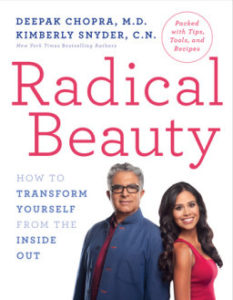Radical Beauty: How to Transform Yourself from the Inside Out. / Deepak Chopra and Kimberly Snyder, 2016. Harmony Books, an Imprint of Crown Publishing. 340 pages, plus 8 plates of color illustrations, chapter notes, and index.

Deepak Chopra’s and Kimberly Snyder’s book is on my Herbs-Nutrition and Ayurveda Gift List for 2017
This post is part of the series on carbohydrates that begins with Eat, Savor, Love Your Carbs!
Carbohydrates provide balance in Radical Beauty, authors Chopra and Snyder have evolved the phrase “pillars of health” to become pillars of beauty, their model of beauty which is fundamental, essential and profound. There are six pillars of beauty. In each pillar, we see how shifting your choice to whole foods, getting the right amount of sleep, tuning into the practice of aligning with nature, physical exercise, and spiritual wholesomeness actually places the means to attain beauty into the reader’s hands.
A stunning quote from the Introduction says:
“You have a right to claim your natural beauty’s highest potential—your Radical Beauty”.
Nothing less than radical beauty is the result of reaching your “highest potential”—a notion that most of us have barely imagined, let alone considered. But how is it possible to reach your highest capacity for beauty, without the products, sessions, plastic surgery, etc. that we are told are essential for attaining the beauty we might already possess?
Medical doctor, writer, and profound thinker Deepak Chopra, and Kimberly Snyder, a certified nutritionist, give the reader all the tools in Radical Beauty. These tools include bodily and mindful practices, at the outset, and ways of preparing your meals. Significantly they provide guidance on how to approach each aspect of cultivating beauty. What stands out is their advice to live a balanced life, especially when it comes to your diet.
The authors infuse the book with the view that balance helps you succeed when it comes to reaching the state of beauty that you aspire to. It may seem surprising, but the authors promote carbohydrates as not only one of the three macronutrients that should be part of your diet, but as beauty foods.
To be clear, they are not looking at refined carbohydrates and sugars—“food products” which should have no place in your diet. You cannot have that donut, that piece of pizza, cake, or white bread, even occasionally!
Oh, where’s the harm in it?
Well, for the short term, the harm would be bad breath, constipation and your gut’s inability to process these items. Suffice it to say these are not beautiful states to be in.
The authors’reasons why refined carbohydrates and sugars are unfavorable to your health and therefore your innate beauty are familiar. Three of these are: refined carbs and sugar foster bad bacteria, skin problems, and accelerate the effects of poor digestion such as bloating and constipation. When digestion is poor or incomplete,
the body suffers. Once the body’s balance is off, beauty suffers. It’s a cascade of imbalances that leads to wrinkles, weight management problems, and thus major health problems that arrive later.
Radical Beauty is not a diet or weight loss manifesto and doesn’t pretend to be. What it does provide is a point of view from two experts who have your back in nutrition and mindful living. When lived to the fullest, the means to total beauty are available to you. Their advice provides a wealth of ideas and information on how a woman like you can increase on a continuum the innate beauty you were born with. With the objective of reaching the goal of radical beauty for yourself and those around you, they suggest eating between 50-70% of your diet in whole food carbohydrates.
That balance, 50-70% carbohydrates from whole food sources, leaves between 30-50% for protein and healthy fats. These are for a vegan diet.
I’m actually glad for the encouragement to eat lots of carbs as 50-70% of my diet! And to hear how healthy and beautifying they are: I will have better digestion and get better sleep, perhaps even lose some weight by eating these amazingly rich foods. At the same time, I appreciate this invitation to arrange my food purchases to make room for the starchy vegetables, legumes and beans, and whole grains that it could consist of.
Meanwhile, realizing that vegan sources of protein share the stage with a group of carbohydrates, I see that protein is also found in leafy vegetables such as kale and broccoli. Hence, a vegan diet takes advantage of the vitamins, minerals and fiber available in whole food vegetables and fruits. A vegan diet does not sort foods into one or another classification by macronutrient. Instead it maximizes nutrients you can get in each food.
Follow


